
Science makes it known,
Engineering makes it work,
Art makes it beautiful.
Model Rockets & Boost/Gliders Programming
This site is intended for those who wish to learn more about programming model rocket and glider systems in D, FORTRAN, Pascal, and Lazarus; also serves as a tutorial about model rockets and gliders. This is an ongoing project covering model rockets, boost/gliders, rocket/gliders, lifting bodies, and Rogallo flexwing gliders. The source files available for download are meant for building your own application and demonstrating how to call subprograms written in multiple programming languages.
Rockets usually consist of three serial stages or less. X axis is the longitudinal axis (or Axis of Symmetry), Y axis is the lateral or transverse axis. Nose tip is at
MRmain is a Lazarus application for input/analysis of a model rocket or parallel stage employing
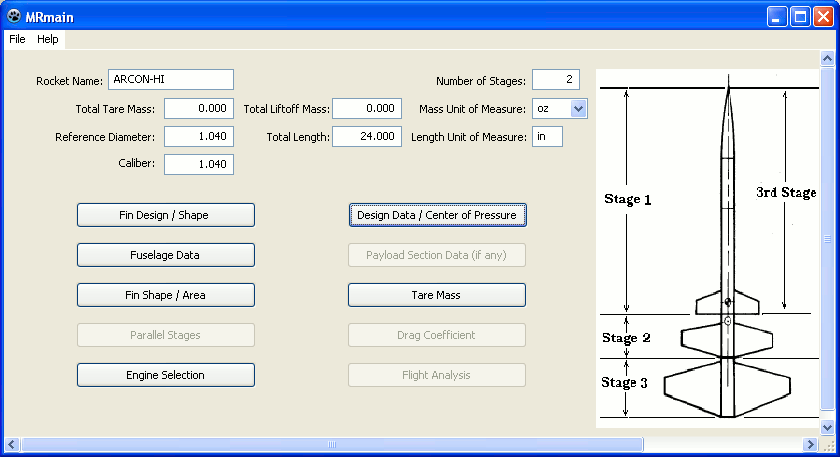
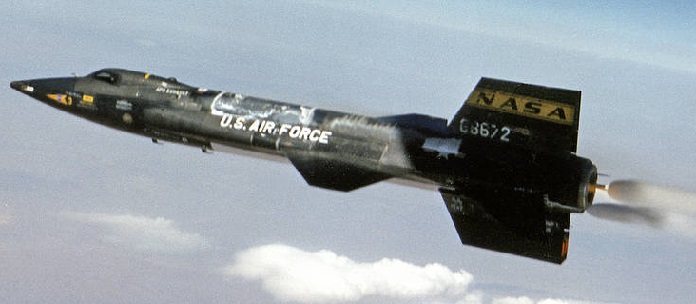
A spaceplane (or Rocket powered glider) is an air vehicle, rocket powered for lift-off, and unpowered glide recovery. In this context, includes
(X-15 Image from NASA Armstrong)
glider01 is a Lazarus application for input of boost/glider,
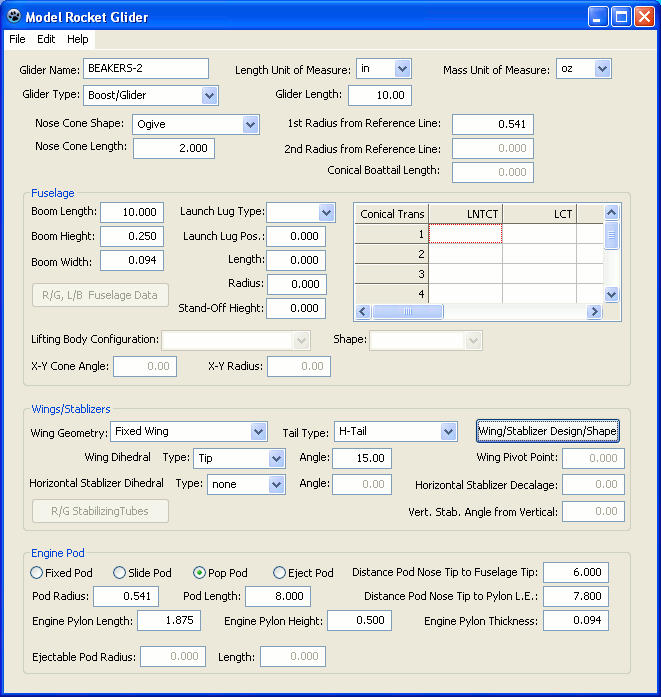
LftBdy10.pas - Lifting Body related functions/procedures. Currently in development.
Both applications share units and .dll. Rockets are dimensioned for six serial stages, gliders for six sets of
|
Calculating Model Rocket Coefficient of Normal Force & Center of Pressure
: mathproc.dll FORTRAN Engineering Subprograms called by Object Pascal .dll;
introduction to rocket aerodynamics & stability;
includes source file downloads - tir33.for, missle.inc, missle02.pas. missle02.pas
includes a Pascal implementation of
ELLIPSE_SEGMENT algorithm from CALCULATING ELLIPSE OVERLAP AREAS,
used for finding the surface area of a rear swept elliptical
fin/wing/stabilizer where the root chord does not pass through
the ellipse origin. Elliptical area / perimeter calculations can
be complex, involving geometric angles, parametric angles,
integrations. Both the unswept/swept elliptical fins/wings area and
perimeter calculations are approximations.
These two .dll are the heart of the system. |
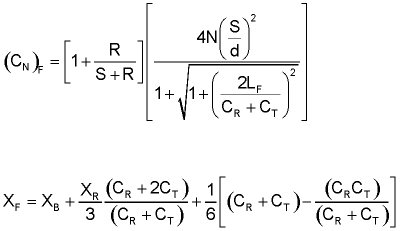
|
|
|
Multi-Stage Model Rocket User Interface
: Lazarus Tab Sheets (TPageControl & TTabSheet) tutorial; each
Tab Sheet represents a model rocket stage. Brief introduction
to Lazarus sub-forms. User interface for inputting rocket design
parameters and Calculating Model Rocket Coefficient of Normal Force
& Center of Pressure. For a stable flight, the Center of Pressure
(cp) must be aft of the Center of Gravity
(cg) by one caliber (largest body diameter).
Each stage configuration is analyzed separately.
Originally this was (and still is) a stand-alone program and the start of this project; now also a MRmain Sub-form. One of two forms that can be used to enter model rocket fin data. During initial design, using a separate Tab Sheet for each stage seemed acceptable. However that was not the case during actual coding and maintenance. |
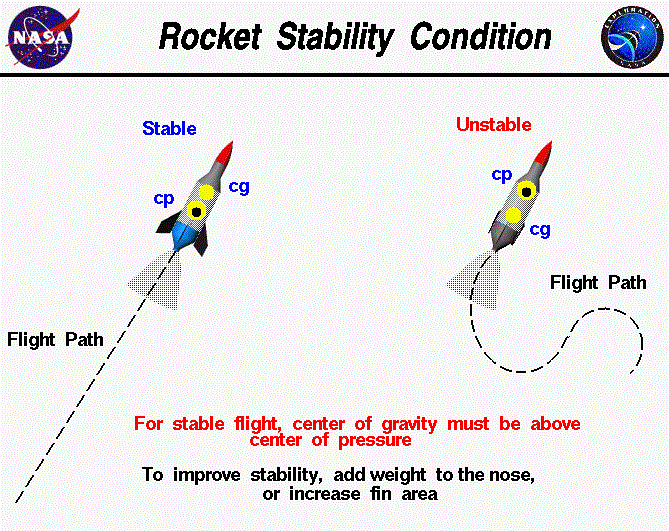
|
1 |
|
Lazarus Body Tubes Sub-forms
: unit/form Body tube data required for CD calculations. Body tubes, nose cone, and conical transition(s) (if any) comprise the model rocket and rocket/glider fuselage. Nose cone and conical transition(s) usually comprise lifting bodies, may include body tubes. From the diagram at right: BC-54 is an example nose cone; ST-56, CPT-103, ST-103, ST-133, and ST-812 are body tubes; BR5-10, BR10-13, and BR8-13 are conical transitions (BR5-10 and BR10-13 are being used as conical shoulders, BR8-13 is being used as conical boattail); BTC-10 is a coupler; EM-8 is an engine mount. (boost/gliders, rocket/gliders, and lifting bodies may use ejectable engine pods) |
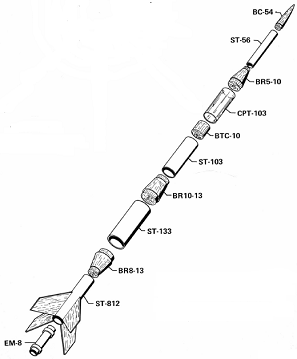
|
2 |
|
Lazarus Sub-form, Model Rocket Fins, and Glider Wings/Stabilizers
: Lazarus Sub-form used by MRmain and glider01; uses TImage.Picture
property, MessageDlg(...), QuestionDlg(...). This form
is used for input of flight surfaces3 Unit defines glider-specific global data. Stores flight surfaces basic data only. Both rockets and lifting bodies refer to flight surfaces as fins. One of two forms that can be used to enter model rocket fin data. This form must be used for entering glider's Page shows examples of boost/gliders, rocket/gliders, and lifting bodies. |
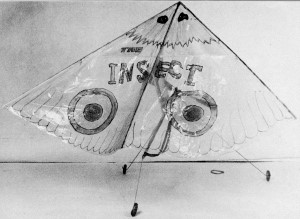
Rogallo Flexwing Glider |
4 |
|
Rocket/Glider External Structural/Stabilizing Body Tubes
: Lazarus Sub-form is used to input External Body Tube data as shown in diagram at right; data required for CD calculations. Includes source code downloads. Currently sub-form only handles |
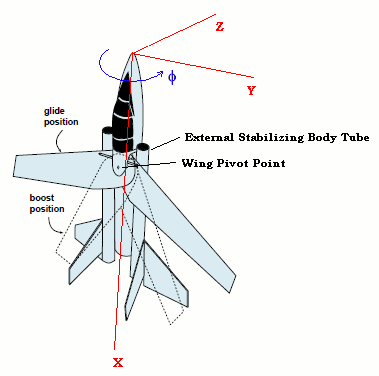
Swing Wing Rocket/Glider |
5 |
|
Model Rocket Parallel Stages
: Lazarus Sub-form user interface for inputting Parallel Stage data and adding
Parallel Stage Pods to a rocket's nth stage; used by MRmain. Also
demonstrates calling FORTRAN mathproc.dll Center of Pressure cp
and Coefficient of Normal Force CNα
subroutines from Lazarus via an Object Pascal Library; includes downloads, compiling
instructions (including brief hints for building sttstcs.for
& mathproc.for, main Lazarus project MRmain).
Parallel Stage data is stored in a separate file, allowing the same Parallel Stage to be used with different model rockets. In order to reduce complexity, several simplifications were made to Parallel Stage Processing. Depending on Parallel Stage Pod length, may move cp forward. |

Soyuz Rocket with 4 parallel stages |
6 |
|
Engine Thrust File I/O - missle05.pas
: Object Pascal Windows program to input and save to a file thrust
points from a model rocket engine thrust time curve (shown at right). Uses
several of the include files and Object Pascal Libraries mentioned on these
pages.
Thrust is a force vector. Provides acceleration and maintains velocity (both of which are also vectors). Demonstrates how to call D procedures using its mangled name or its unmangled name when declared as extern (C), Engine Thrust Points right click short cut popup menu processing via calls to D module hedtio. When Engine Thrust Points > 0.0, time interval is 0.1 seconds; when Engine Thrust Points = 0.0, time interval is 0.5 seconds. When completed, MRcommon.pas procedure prcsEngFile (...) will be used to process thrust data for flight analysis. |

|
7 |
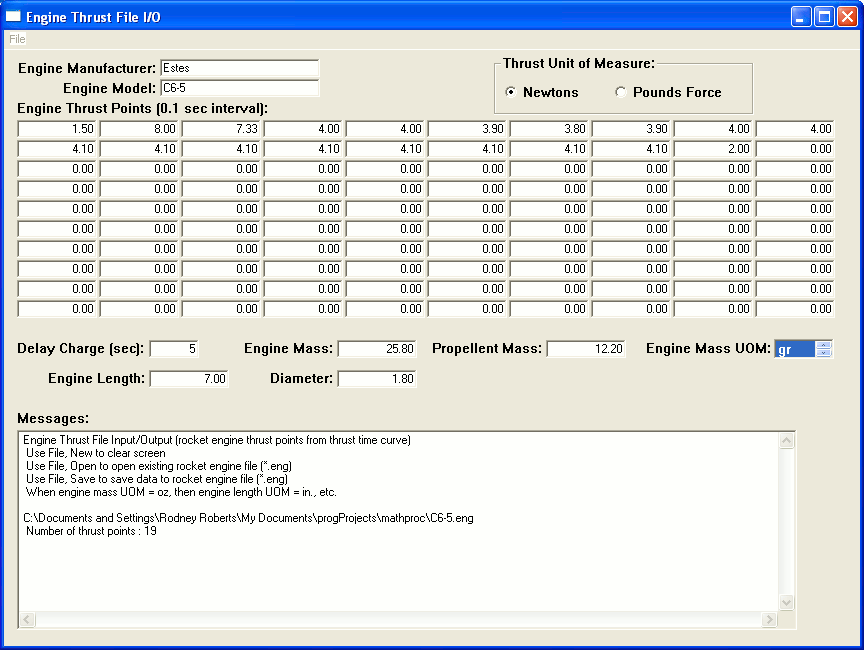
For aircraft, for constant velocity straight and level flight, Thrust = Drag, Lift = Weight
LiftL = CLα ½ ρ V2 ArL : Lift Force (vector) CLα : Coefficient of Lift at angle of attack α; dimensionless ½ ρ V2 : dynamic pressure ρ : air density V : airstream velocity (vector) Ar : reference area; definition varies depending on vehicle type and force (L, N, or D) being calculated. DragD = CD ½ ρ V2 Ar |
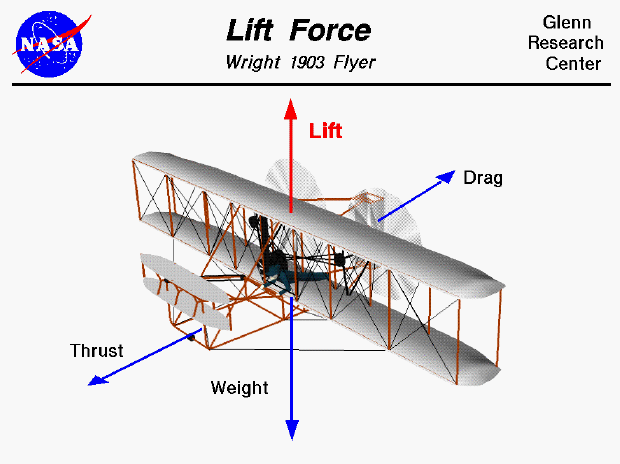
|
8 |
D, aerodynamic drag, measured as a force vector, is resistance to flight through air. Drag Coefficient (CD) is a dimensionless measurement of a flight vehicle's resistance to airflow due to its design, shape, and finish. In simplest terms, drag can be pressure drag (compression drag), friction drag, interference drag (drag between airframe components), or induced drag (drag due to lift). aero030 is a D Windows program to estimate CD for model rockets, parallel stages,
1. Image from Conditions for Rocket Stability:
2. Image from Centuri Model Rocket Designers Manual, p. 19
3. The definition of flight surfaces has been expanded from its textbook definition to include main wing.
4. Insect Article & Plans
April 1970 American Aircraft Modeler
5. Image from TR-4 Model Rocket Technical Report Boost Gliders, p. 12, and modified.
6. Image created from PixelSquid.com
7. Image from NASA Space Flight Systems
8. Image from NASA Glenn Research Center
Forces acting on an air vehicle in flight. For rockets, L is usually ignored; Normal Force N is of greater significance.
|
Primary Site:
|
Linked In Public Profile:
|
Website is supported on DESKTOP platforms only. This index page is an expanded "alternate" main page to selected pages of author's website.
To return to this index page, use the Browser's BACK button.
The downloadable source code files (version/revision history unavailable) are enhanced (including error fixes) and tested periodically - check for revised versions.
| Free web hosting provided by |

|
Any and all © copyrights, ™ trademarks, or other intellectual property (IP) mentioned/used here are the property of their respective owners. No infringement is intended. If you suspect infringement occurred, please contact me at hp3000guru@yahoo.com, fully describing. Feel free to use any of the above in your project (without violating any intellectual property rights); please give credit (same idea as Copyleft).